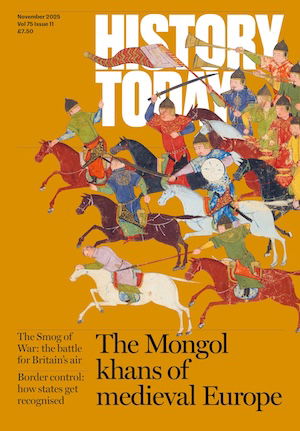A History of Everything
Paul Lay on the rise of 'big history'.
 It is rare that one reads a history book so compelling and so stimulating that one forgets to eat, but that was my experience of Geoffrey Parker’s magnificent Global Crisis, a magisterial, near 900-page study of the world in the 17th century that centres on the relationship between climate and human conflict, of which there was a great deal. Parker’s study is what I call Big History, though, judging by what others mean by that term, I am plainly parochial.
It is rare that one reads a history book so compelling and so stimulating that one forgets to eat, but that was my experience of Geoffrey Parker’s magnificent Global Crisis, a magisterial, near 900-page study of the world in the 17th century that centres on the relationship between climate and human conflict, of which there was a great deal. Parker’s study is what I call Big History, though, judging by what others mean by that term, I am plainly parochial.
At the Anglo-American Conference held at London’s Institute of Historical Research in 2000, Eric Hobsbawm was asked what field of history he would concentrate on were he starting out as a historian today. He had no hesitation in saying that he would set his sights on ‘Deep History’, of the kind pioneered by Daniel Lord Smail and his team at Harvard: pushing the barrier between history and pre-history ever further back, using the science of genetics to establish new primary sources from the language of genes. Anyone who saw the recent Ice Age Art exhibition at the British Museum, which shone shafts of light on the darkest, distant corners of human history, will understand the appeal of such a project. But even ‘Deep History’ sets its sights low in comparison with ‘Big History’.
‘To understand the integrated history of the Cosmos, Earth, Life and Humanity’: such is the almost ludicrously ambitious ambition of the International Big History Association, founded in Italy in 2010. It is the brainchild of historians such as David Christian, founder of the Big History Institute at Macquarie University in Sydney, Australia, and Fred Spier, author of The Structure of Big History (1996). Rather than limit the historian’s remit to the mere 200,000-year existence of Homo Sapiens, of which there is still so much to explore, Big History embraces the entire 13.8 billion years from the Big Bang onwards, through the Earth’s formation 4.6 billion years ago, right up to the present. It is a task that demands a high degree of interdisciplinarity (an ugly word for a noble ideal), embracing within its unwieldy remit chemistry, biology, physics, geology, cosmology, climatology and much else.
Big History, though recently christened, has a long lineage. Oswald Spengler and Arnold Toynbee, though little read today and even less well regarded, sought to create totalising histories. Fernand Braudel and the French Annales school proved more fruitful, examining the interaction of human societies with long-term geographical, geological and meteorological change. Jared Diamond and Ian Morris have followed in their footsteps, reaching a wide audience with erudite, genuinely global histories. Yet all, successful or not, deferred wittingly or unwittingly to Alexander Pope’s maxim that ‘the proper study of mankind is man’. I wish Big History and its practitioners well and I am sure it will add greatly to the sum of human knowledge, but will its mind-numbing scope hinder rather than aid insight, reducing the vast past to inhuman abstraction? To paraphrase Quentin Skinner, it is not that ‘such histories can sometimes go wrong, but that they can never go right’.




